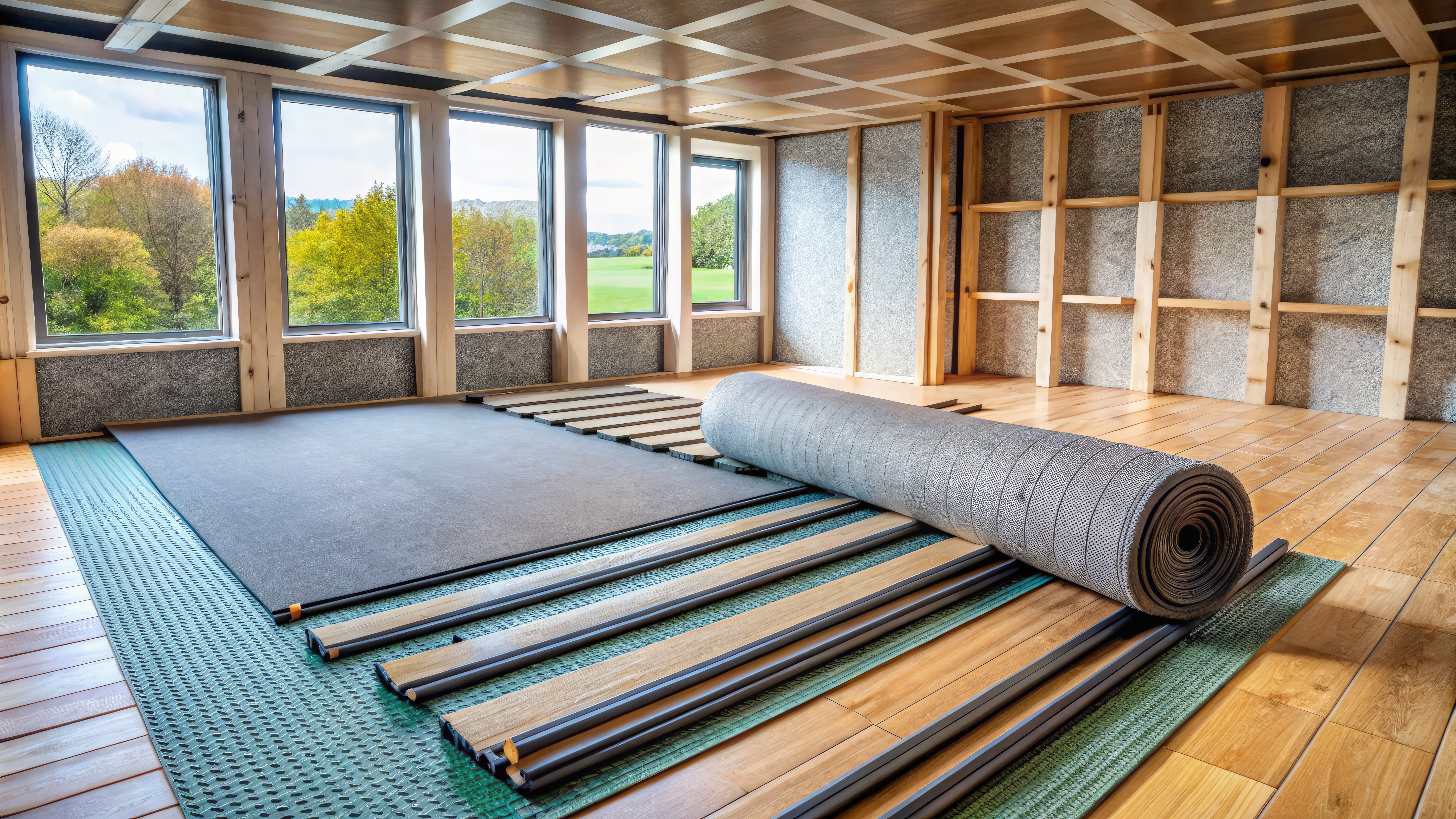Why Soundproof Floors Matter
 Soundproofing helps to create a quieter, more peaceful environment by preventing sound from traveling between rooms or from one level to another. For example, in apartments or condos, soundproofing can help reduce disturbances from neighbors, while in offices or recording studios, it can ensure confidentiality and minimize distractions. Soundproof floors are especially beneficial for people who have small children, pets, or live in high-traffic areas.
Soundproofing helps to create a quieter, more peaceful environment by preventing sound from traveling between rooms or from one level to another. For example, in apartments or condos, soundproofing can help reduce disturbances from neighbors, while in offices or recording studios, it can ensure confidentiality and minimize distractions. Soundproof floors are especially beneficial for people who have small children, pets, or live in high-traffic areas.
How Soundproof Floors Work
The key to soundproofing lies in the materials and techniques used to absorb, block, or isolate sound. Common soundproofing materials include dense rubber, foam underlays, acoustic mats, and resilient channels. These materials are either added underneath the existing floor or incorporated directly into the floor structure during construction or renovation.
Soundproof floors can significantly reduce the amount of noise heard in the room below by creating a barrier that absorbs and dampens sound vibrations. Additionally, they help improve the acoustics inside the space by controlling sound reflection.
Soundproofing Materials for Floors
- Mass-Loaded Vinyl (MLV)
Mass-loaded vinyl is a dense material designed to block sound. It can be installed under carpets, hardwood, or tile flooring. MLV is especially effective at reducing airborne sound and impact noise, such as footsteps. It’s flexible, thin, and doesn’t take up much space, making it an ideal option for soundproofing existing floors. - Acoustic Underlayments
Acoustic underlayments are foam or rubber-based materials placed between the floor and the subfloor. They are designed to absorb sound vibrations and reduce noise transmission.- Rubber underlayment: Known for its high-density properties, rubber absorbs sound effectively and prevents noise from traveling between floors.
- Cork underlayment: While not as dense as rubber, cork is a natural material that also helps reduce sound. It’s often used in areas that need sound insulation while being eco-friendly.
- Resilient Channels
Resilient channels are metal strips or brackets that are installed between the subfloor and the floor material, creating a gap that helps decouple the two surfaces. This reduces the amount of direct vibration transmission, which in turn minimizes sound transfer. This method is often used during the construction or renovation phase for added soundproofing. - Carpet and Padding
Carpet, especially when paired with thick padding, can be an effective way to reduce sound, especially impact noise (e.g., footsteps). The fibers of the carpet absorb sound, and the padding beneath it provides additional cushioning to minimize noise from traveling through the floor. - Concrete Slab
For multi-story buildings, a concrete slab is one of the most effective materials for soundproofing floors. Its mass helps to block both airborne and impact sounds. While not a flexible option for retrofitting existing homes, concrete is ideal in new construction or in basements where soundproofing is crucial. - Acoustic Mats
Acoustic mats are typically made from rubber or recycled materials and are installed beneath floors, especially in areas prone to high foot traffic. These mats act as a buffer, absorbing sound and preventing it from traveling through the floor. - Floating Floors
A floating floor system consists of layers of materials that are not attached directly to the subfloor. These can include a combination of soundproofing mats, underlayment, and finished floor coverings. By decoupling the floor from the underlying structure, floating floors prevent sound from being transferred from one floor to another.
Soundproofing Methods for Floors
- Decoupling the Floor Structure
One of the most effective methods of soundproofing is decoupling, which involves isolating the floor from the building structure to reduce sound transmission. This can be achieved by using resilient channels or floating floor systems. This method minimizes both impact noise (like footsteps) and airborne noise. - Adding Mass
Sound travels through materials based on their mass, so adding mass to your floor can effectively block sound. Mass-loaded vinyl, thicker carpets, or even an additional layer of plywood can help increase the floor’s density, preventing sound from passing through. For more intensive soundproofing, additional layers of drywall or concrete can also be added. - Absorbing Sound with Insulation
Insulation placed between the floor and the subfloor can help absorb sound vibrations. Materials like fiberglass, foam, or mineral wool are commonly used. Insulation helps to reduce the impact of both airborne and impact noise by absorbing sound waves before they travel to the next room or floor. - Installing a Soundproof Barrier
Installing a soundproof barrier between floors is a more invasive but highly effective method. This can be achieved by placing a combination of MLV, acoustic mats, and underlayments between layers of flooring. These barriers act as a soundproofing “sandwich” that prevents sound from traveling upward or downward. - Floor Coverings and Rugs
For more affordable soundproofing, floor coverings such as large rugs or carpets can help reduce noise levels. This is particularly effective for managing impact noise in apartments, homes, and offices where loud footsteps or dropped items create disturbances. Adding a thick rug pad underneath can further enhance noise reduction.
Choosing the Best Method
The best soundproofing solution depends on the specific needs of your space, whether it’s for reducing impact noise, blocking airborne sounds, or a combination of both.
- For impact noise (footsteps, dropped objects), thicker carpets, underlayment, and resilient channels are effective.
- For airborne noise (voices, television, music), adding mass (such as mass-loaded vinyl) or installing soundproof barriers and insulation are recommended.
In multi-story buildings or apartments, combining several methods—such as installing an acoustic underlayment with mass-loaded vinyl—will provide optimal results.
By understanding these materials and methods, you can create a more soundproof environment, enhancing the peace and privacy of your living or working space.